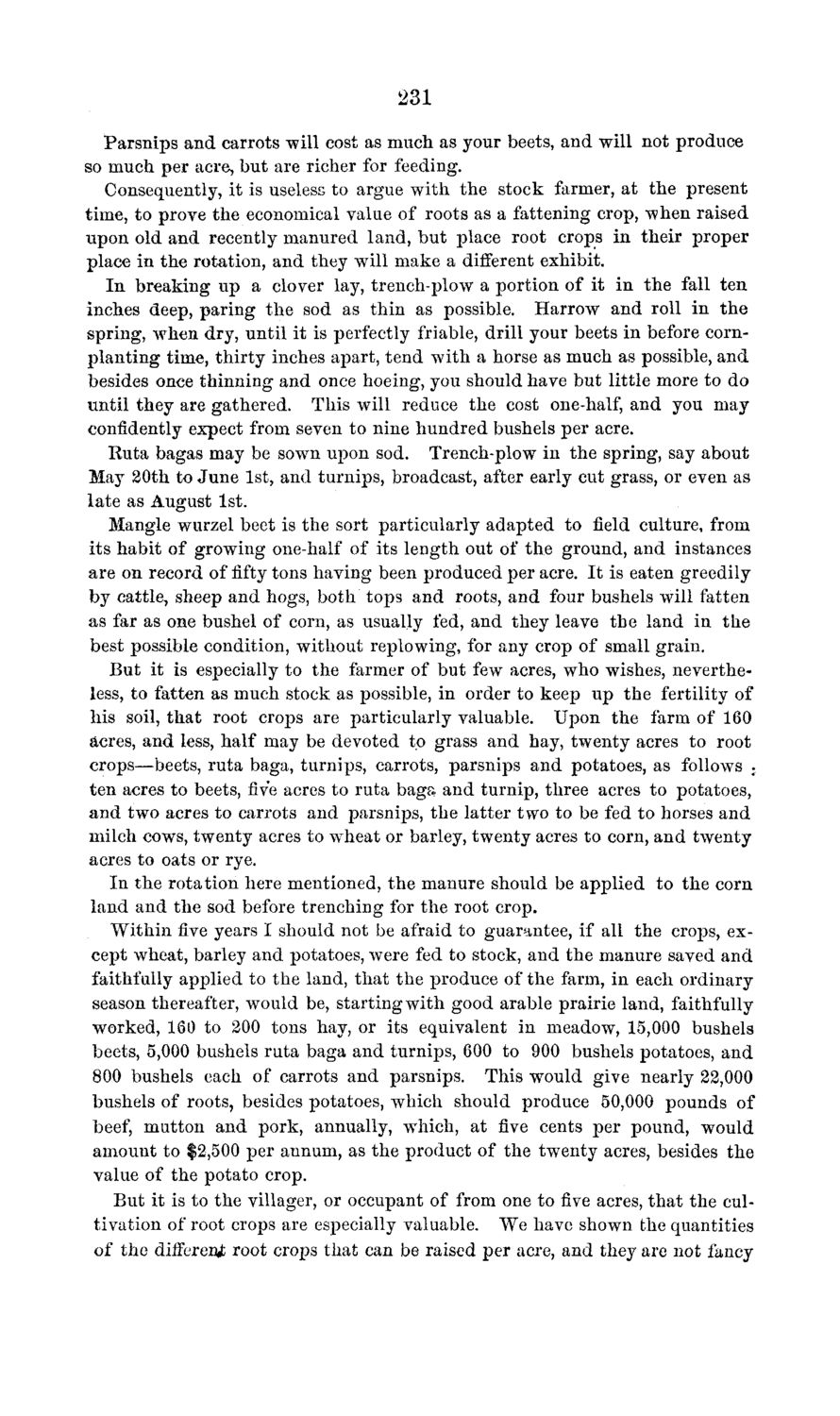| |
| |
Caption: Board of Trustees Minutes - 1869
This is a reduced-resolution page image for fast online browsing.

EXTRACTED TEXT FROM PAGE:
231 Parsnips and carrots will cost as much as your beets, and will not produce so much per acre, but are richer for feeding. Consequently, it is useless to argue with the stock farmer, at the present time, to prove the economical value of roots as a fattening crop, when raised upon old and recently manured land, but place root crops in their proper place in the rotation, and they will make a different exhibit. I n breaking up a clover lay, trench-plow a portion of it in the fall ten inches deep, paring t h e sod as thin as possible. Harrow and roll in t h e spring, when dry, until it is perfectly friable, drill your beets in before cornplanting time, thirty inches apart, tend with a horse as much as possible, and besides once thinning and once hoeing, you should have but little more to do until they are gathered. This will reduce the cost one-half, and you may confidently expect from seven to nine hundred bushels per acre. Ruta bagas may be sown upon sod. Trench-plow in the spring, say about May 20th to J u n e 1st, and turnips, broadcast, after early cut grass, or even as late as August 1st. Mangle wurzel beet is the sort particularly adapted to field culture, from its habit of growing one-half of its length out of the ground, and instances are on record of fifty tons having been produced per acre. It is eaten greedily by cattle, sheep and hogs, both tops and roots, and four bushels will fatten as far as one bushel of corn, as usually fed, and they leave the land in t h e best possible condition, without replowing, for any crop of small grain. But it is especially to the farmer of but few acres, who wishes, nevertheless, to fatten as much stock as possible, in order to keep up the fertility of his soil, that root crops are particularly valuable. Upon the farm of 160 acres, and less, half may be devoted to grass and hay, twenty acres to root crops—beets, ruta baga, turnips, carrots, parsnips and potatoes, as follows ; ten acres to beets, five acres to ruta baga, and turnip, three acres to potatoes, a n d two acres to carrots and parsnips, the latter two to be fed to horses and milch cows, twenty acres to wheat or barley, twenty acres to corn, and twenty acres to oats or rye. In the rotation here mentioned, the manure should be applied to the corn land and the sod before trenching for the root crop. Within five years I should not be afraid to guarantee, if all the crops, except wheat, barley and potatoes, were fed to stock, and the manure saved and faithfully applied to the land, that the produce of the farm, in each ordinary season thereafter, would be, starting with good arable prairie land, faithfully worked, 160 to 200 tons hay, or its equivalent in meadow, 15,000 bushels beets, 5,000 bushels ruta baga and turnips, 600 to 900 bushels potatoes, and 800 bushels each of carrots and parsnips. This would give nearly 22,000 bushels of roots, besides potatoes, which should produce 50,000 pounds of beef, mutton and pork, annually, which, at five cents per pound, would amount to $2,500 per annum, as the product of the twenty acres, besides the value of the potato crop. But it is to the villager, or occupant of from one to five acres, that the cultivation of root crops are especially valuable. We have shown the quantities of the different root crops that can be raised per acre, and they are not fancy
| |